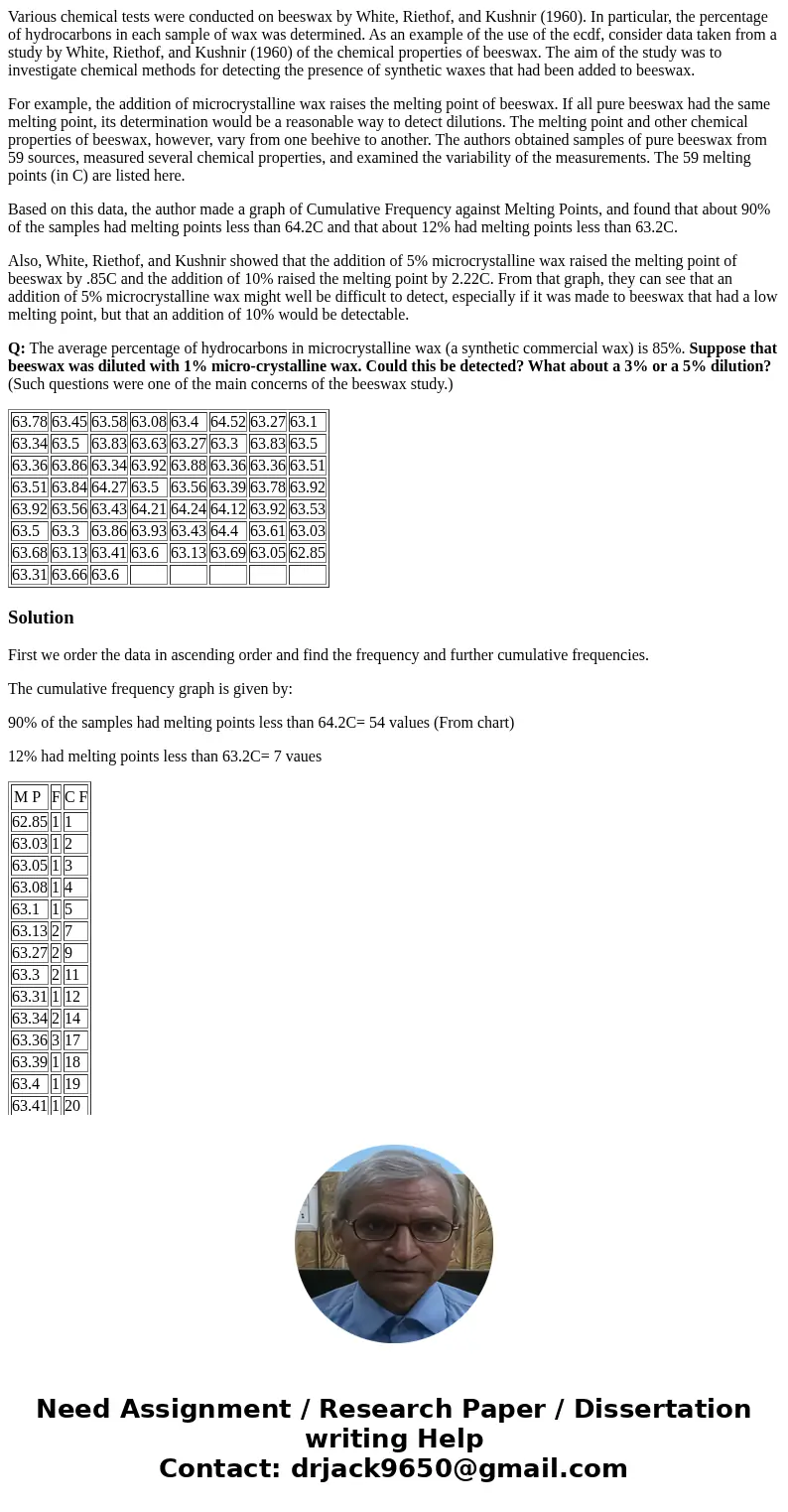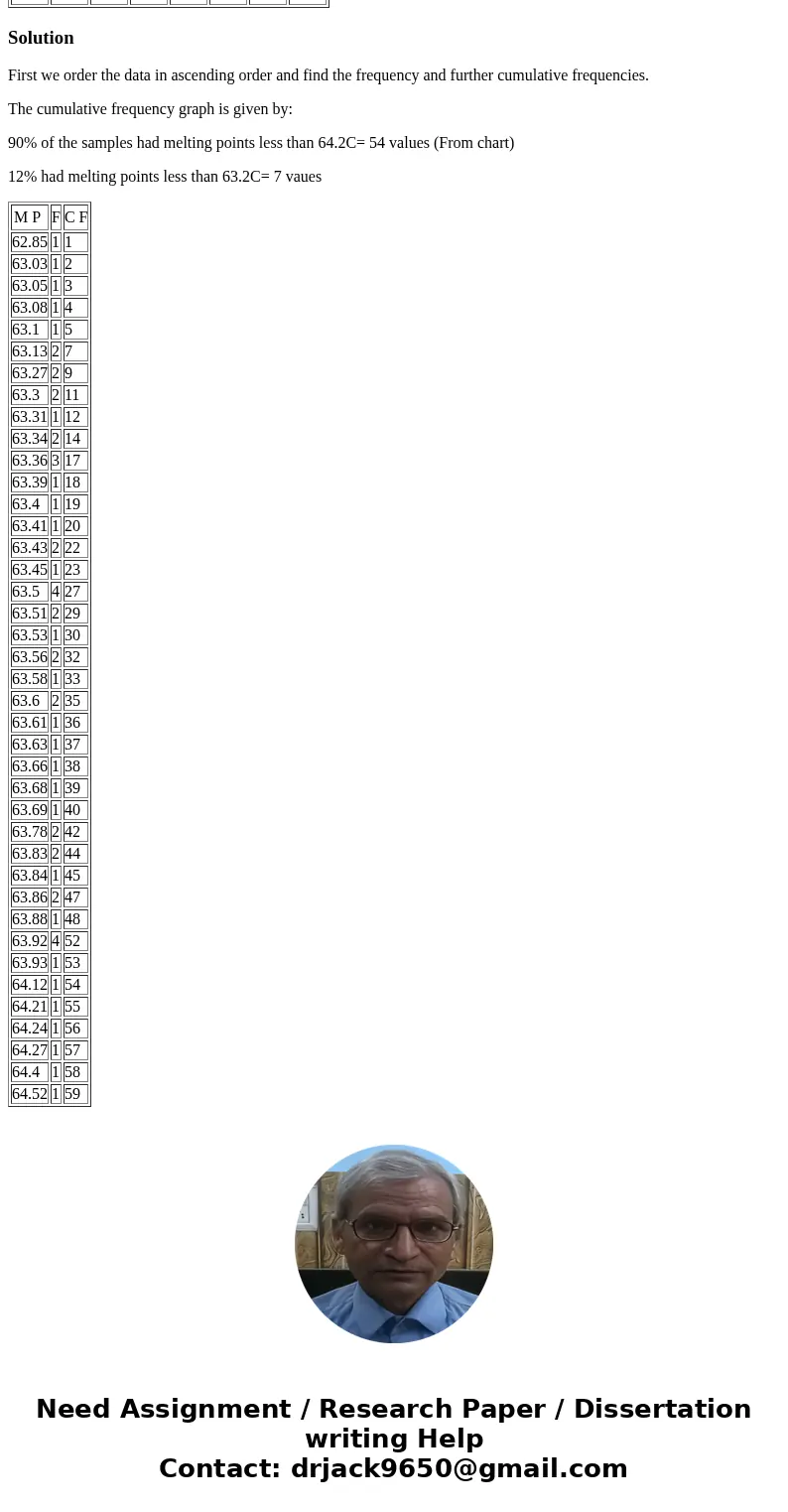Various chemical tests were conducted on beeswax by White Ri
Various chemical tests were conducted on beeswax by White, Riethof, and Kushnir (1960). In particular, the percentage of hydrocarbons in each sample of wax was determined. As an example of the use of the ecdf, consider data taken from a study by White, Riethof, and Kushnir (1960) of the chemical properties of beeswax. The aim of the study was to investigate chemical methods for detecting the presence of synthetic waxes that had been added to beeswax.
For example, the addition of microcrystalline wax raises the melting point of beeswax. If all pure beeswax had the same melting point, its determination would be a reasonable way to detect dilutions. The melting point and other chemical properties of beeswax, however, vary from one beehive to another. The authors obtained samples of pure beeswax from 59 sources, measured several chemical properties, and examined the variability of the measurements. The 59 melting points (in C) are listed here.
Based on this data, the author made a graph of Cumulative Frequency against Melting Points, and found that about 90% of the samples had melting points less than 64.2C and that about 12% had melting points less than 63.2C.
Also, White, Riethof, and Kushnir showed that the addition of 5% microcrystalline wax raised the melting point of beeswax by .85C and the addition of 10% raised the melting point by 2.22C. From that graph, they can see that an addition of 5% microcrystalline wax might well be difficult to detect, especially if it was made to beeswax that had a low melting point, but that an addition of 10% would be detectable.
Q: The average percentage of hydrocarbons in microcrystalline wax (a synthetic commercial wax) is 85%. Suppose that beeswax was diluted with 1% micro-crystalline wax. Could this be detected? What about a 3% or a 5% dilution?(Such questions were one of the main concerns of the beeswax study.)
| 63.78 | 63.45 | 63.58 | 63.08 | 63.4 | 64.52 | 63.27 | 63.1 |
| 63.34 | 63.5 | 63.83 | 63.63 | 63.27 | 63.3 | 63.83 | 63.5 |
| 63.36 | 63.86 | 63.34 | 63.92 | 63.88 | 63.36 | 63.36 | 63.51 |
| 63.51 | 63.84 | 64.27 | 63.5 | 63.56 | 63.39 | 63.78 | 63.92 |
| 63.92 | 63.56 | 63.43 | 64.21 | 64.24 | 64.12 | 63.92 | 63.53 |
| 63.5 | 63.3 | 63.86 | 63.93 | 63.43 | 64.4 | 63.61 | 63.03 |
| 63.68 | 63.13 | 63.41 | 63.6 | 63.13 | 63.69 | 63.05 | 62.85 |
| 63.31 | 63.66 | 63.6 |
Solution
First we order the data in ascending order and find the frequency and further cumulative frequencies.
The cumulative frequency graph is given by:
90% of the samples had melting points less than 64.2C= 54 values (From chart)
12% had melting points less than 63.2C= 7 vaues
| F | C F | |
| 62.85 | 1 | 1 | |
| 63.03 | 1 | 2 | |
| 63.05 | 1 | 3 | |
| 63.08 | 1 | 4 | |
| 63.1 | 1 | 5 | |
| 63.13 | 2 | 7 | |
| 63.27 | 2 | 9 | |
| 63.3 | 2 | 11 | |
| 63.31 | 1 | 12 | |
| 63.34 | 2 | 14 | |
| 63.36 | 3 | 17 | |
| 63.39 | 1 | 18 | |
| 63.4 | 1 | 19 | |
| 63.41 | 1 | 20 | |
| 63.43 | 2 | 22 | |
| 63.45 | 1 | 23 | |
| 63.5 | 4 | 27 | |
| 63.51 | 2 | 29 | |
| 63.53 | 1 | 30 | |
| 63.56 | 2 | 32 | |
| 63.58 | 1 | 33 | |
| 63.6 | 2 | 35 | |
| 63.61 | 1 | 36 | |
| 63.63 | 1 | 37 | |
| 63.66 | 1 | 38 | |
| 63.68 | 1 | 39 | |
| 63.69 | 1 | 40 | |
| 63.78 | 2 | 42 | |
| 63.83 | 2 | 44 | |
| 63.84 | 1 | 45 | |
| 63.86 | 2 | 47 | |
| 63.88 | 1 | 48 | |
| 63.92 | 4 | 52 | |
| 63.93 | 1 | 53 | |
| 64.12 | 1 | 54 | |
| 64.21 | 1 | 55 | |
| 64.24 | 1 | 56 | |
| 64.27 | 1 | 57 | |
| 64.4 | 1 | 58 | |
| 64.52 | 1 | 59 |


 Homework Sourse
Homework Sourse